Breast rashes: A symptom of cancer or something else

Breast rashes: An overview
A breast rash is a skin condition that affects the skin of the breasts causing redness, irritation, itching, or pain on the skin of the breast. It can affect the area under the breasts, between the breasts, or on the skin around nipples. Breast rash can also affect the appearance of the breast causing discoloration, uneven skin texture, or other visible changes.
Breast rashes can be caused by a variety of factors. Some common factors that causes breast rashes are,
- Fungal infections: Fungal infections such as tinea versicolor can cause red, scaly patches on the skin of the breast.
- Contact dermatitis: This occurs when the skin comes into contact with an irritant, such as a certain type of fabric, detergent, or perfume, and causes a rash.
- Allergic reactions: Some people may develop a rash on the breast due to an allergic reaction to a food, medication, or cosmetic product.
- Eczema: This is a chronic skin condition that can cause dry, itchy, and inflamed skin on the breast.
- Psoriasis: This is a chronic autoimmune disease that can cause scaly patches on the skin of the breast.
- Heat: Heat rashes occur when sweat ducts become blocked and sweat is trapped under the skin causing a rash on the skin of the breast.
- Hormonal changes: Hormonal fluctuations can cause changes in the skin’s oil production, leading to clogged pores and skin irritation. In particular, women may experience breast rash as a result of hormonal changes associated with menstruation, pregnancy, and breastfeeding.
- Medical conditions: Certain medical conditions such as inflammatory breast cancer and Paget’s disease can cause severe breast rashes.
Breast rashes can be caused by medical conditions and also by general factors. This article will provide you a brief knowledge about breast rashes, causes of breast rashes, identifying the signs of breast rashes that occur due to breast cancer, treatment methods and the way to contact medical service providers who can help to treat breast rashes.
Types of breast rashes
There are different types of breast rashes that can occur on the breast, each with its own appearance and symptoms. Some of the common types of breast rashes are,
Intertrigo
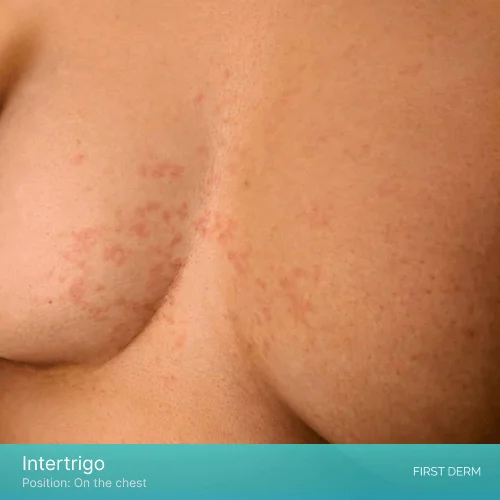
A close-up of a woman’s chest showing red patches of skin irritation caused by Intertrigo
A rash that occurs when the skin folds under the breast rub against each other and cause friction, irritation, and inflammation. It can also be caused by moisture, heat, sweat, or lack of air circulation in the area. Intertrigo can look like a red, raw, or moist patch of skin that may have cracks, blisters, or scales. It can cause itching, burning, or pain. It can also become infected by bacteria or fungi and produce a foul odor or discharge. Intertrigo is most prevalent in obese people 1 .
Yeast infection
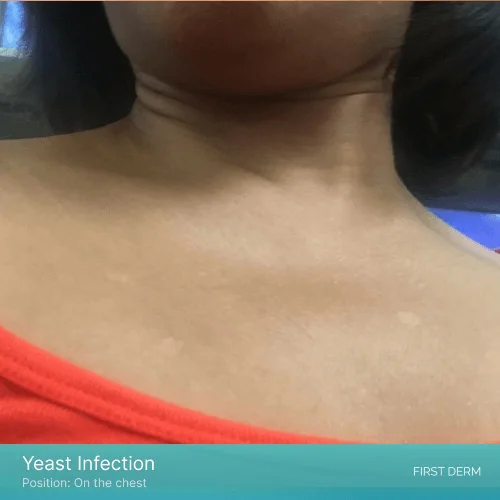
Yeast infection is a common type of breast rash that occurs when the skin is exposed to moist and warm conditions
A type of fungal infection that can affect the skin under the breast or around the nipple. It is caused by an overgrowth of a yeast called Candida albicans that normally lives on the skin. Yeast infection can look like a red, scaly, or flaky rash that may have white patches or pustules. It can cause itching, burning, or soreness. It can also affect the nipple and cause cracking, bleeding, or discharge.
Heat rash
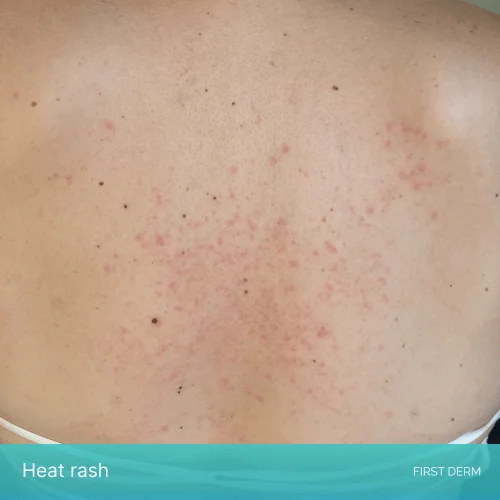
Heat rash is a skin condition that occurs when sweat ducts get blocked and trap sweat under the skin. It can cause small bumps, blisters, and blackheads on the affected area
A rash that occurs when the sweat glands under the breast become blocked and trapped under the skin, causing small bumps and blisters. It is caused by exposure to hot and humid weather or wearing tight or synthetic clothing that does not allow the skin to breathe. Heat rash can look like a cluster of tiny red or pink dots that may have clear fluid inside. It can cause itching, prickling, or tingling sensation.
Nipple eczema
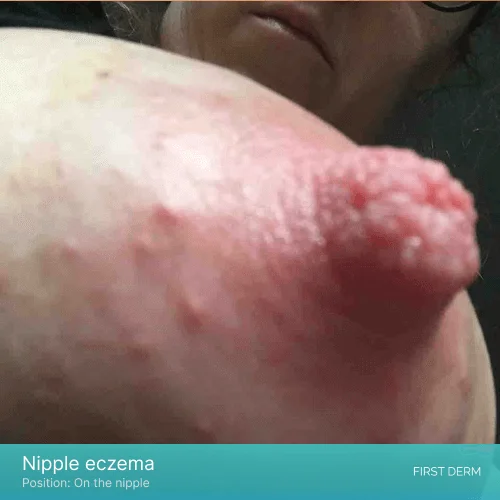
Nipple eczema is a type of dermatitis that affects the nipple and areola. It can be caused by genetics, environmental factors, or contact allergens.
A type of eczema that affects the skin around the nipple and areola. It is caused by an inflammation of the skin due to irritation from clothing, cosmetics, or breastfeeding. Nipple eczema can look like a dry, cracked, or scaly rash that may have redness or swelling. It can cause itching, burning, or pain. It can also affect the nipple and cause bleeding or discharge.
Contact dermatitis
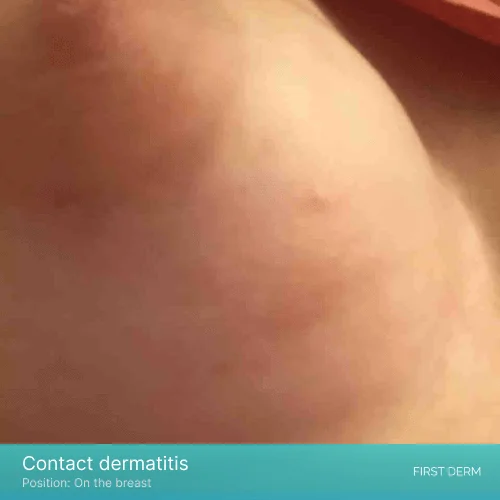
Contact dermatitis can be caused by genetic factors, environmental triggers, irritants or allergens
A rash that occurs when the skin comes in contact with an irritant or allergen, such as poison ivy, latex, or metal. It is caused by an immune reaction of the skin to the substance. Contact dermatitis can look like a red, itchy, or blistered rash that may have oozing or crusting. It can cause burning, stinging, or pain.
Breast cancer rashes
Breast cancer rashes are rashes that occur on the breast due to a type of breast cancer that affects the skin. They differ from other types of breast rashes in that they are usually persistent, progressive, and unresponsive to conventional treatments. They may also be accompanied by other signs and symptoms of breast cancer, such as changes in the shape or size of the breast, nipple discharge or inversion, lumps or masses in the breast or underarm, or swollen lymph nodes.
Two main types of breast cancer rashes are present namely inflammatory breast cancer (IBC) and Paget’s disease of the breast.
Inflammatory breast cancer (IBC)
A rare and aggressive type of breast cancer that causes swelling, redness, and warmth of the breast. It can also cause dimpling or pitting of the skin, taking on the texture of an orange peel. Other symptoms can include pain, tenderness, heaviness, burning, or itching of the breast. The nipple may also become flattened or inverted. The affected breast may be larger than the other one. The rash may spread to the chest wall or underarm area. The lymph nodes may also be enlarged.
Paget’s disease of the breast
A rare type of breast cancer that affects the skin of the nipple and the surrounding area (areola) 2 . It can cause a red, scaly, or flaky rash that may have crusts or oozing. It can also cause itching, burning, pain, or bleeding of the nipple. The nipple may also become inverted or retracted. The rash may spread to other parts of the breast. There may also be a lump or mass in the underlying breast tissue.
Diagnosis and treatment of breast rashes
Diagnosing a Breast Rash
To diagnose a breast rash, a healthcare provider will typically begin with a physical examination of the affected area. During the exam, they will look for signs of inflammation, redness, scaling, or other abnormalities on the skin. They may also ask about the medical history, any medications currently in use, and recent activities, such as exposure to new products or fabrics.
In some cases, healthcare providers may recommend additional tests to help diagnose the underlying cause of the rash. These tests may include:
- Skin biopsy: A small sample of skin is removed and examined under a microscope to check for signs of infection or inflammation.
- Skin culture: A swab is taken of the affected area and sent to a laboratory to check for bacterial or fungal infections.
- Mammogram or breast ultrasound: These tests may be recommended if there are concerns about breast cancer or other underlying conditions.
When to See a Doctor
If you are experiencing a breast rash, it is important to see a healthcare provider if the rash is severe, lasts more than a few days, or is accompanied by other symptoms, such as fever or swollen lymph nodes. You should also seek medical attention if the rash is spreading rapidly, or if you have a weakened immune system due to a medical condition or medication. In addition, if you are experiencing any breast pain, nipple discharge, or other breast-related symptoms, you should seek medical attention as soon as possible to rule out any serious conditions.
Treating a Breast Rash
Treatment for a breast rash depends on the underlying cause. For example:
- Bacterial infections may be treated with antibiotics.
- Fungal infections may be treated with antifungal medications.
- Allergic reactions may be treated with topical or oral steroids or antihistamines.
- Intertrigo may be treated with topical creams and keeping the area clean and dry.
In addition to treating the underlying cause, it is important to practice good hygiene. Some good hygienic practices to help prevent breast rashes are,
- Keep the area clean: Gently wash the breast area with mild soap and warm water daily to remove sweat, oil, and dirt.
- Dry the area thoroughly: After washing, gently pat the breast area dry with a soft towel. Avoid rubbing, which can irritate the skin.
- Wear loose, breathable clothing: Wear loose-fitting clothing made of breathable fabrics like cotton to allow air to circulate and prevent moisture buildup.
- Change sweaty clothes: Change sweaty or wet clothes, such as undergarments or workout clothes, as soon as possible.
- Avoid irritants: Avoid using perfumed or scented products, harsh soaps, and detergents that can irritate the skin.
- Moisturize: Apply a gentle, fragrance-free moisturizer to keep the skin hydrated and prevent dryness.
- Check for proper fit: Ensure that the clothing items fit properly and do not rub the skin.
- Stay cool: Avoid excessive heat and humidity, which can lead to sweating and increase the risk of rashes.
- Practice good breastfeeding hygiene: Breastfeeding mothers practice good hygiene by washing hands and nipples before and after breastfeeding, and changing nursing pads regularly.
Treating Breast Cancer Rashes
If a breast rash is caused by breast cancer, treatment will depend on the stage and type of cancer. Options may include surgery to remove the cancerous tissue, chemotherapy to kill cancer cells, and radiation therapy to shrink tumors or prevent cancer from spreading. In some cases, targeted therapy or hormone therapy may also be recommended to treat breast cancer. It is important to work closely with a healthcare provider to develop a treatment plan that is designed to the specific needs and medical history.
Summary
Breast rashes affect the skin of the breast by changing the appearance of the breast and causing discomfort. Breast rashes are caused by a variety of factors including medical conditions and general factors. Different types of breast rashes affect women such as intertrigo, yeast infections, heat rashes, eczema and contact dermatitis. There are two main types of breast cancer rashes namely rashes caused by inflammatory breast cancer and paget’s disease.
Breast rashes can be diagnosed by healthcare providers by physical examination, using the patient’s history, and by checking the recent activities of the patient. Additional tests such as skin biopsy, skin culture, and mammogram are taken for accurate diagnosis of breast cancer rashes.
If a patient is experiencing a severe rash, she must consult a doctor immediately. A healthcare provider can provide appropriate treatment for the breast rash. Along with the proper treatment, patients should follow good hygienic practices.
References
- Jahangir Moini, Mohtashem Samsam, Skin problems, Intertrigo, https://www.sciencedirect.com/topics/medicine-and-dentistry/intertrigo
- Cansu Karakas, Paget’s disease of the breast, https://www.ncbi.nlm.nih.gov/pmc/articles/PMC3263015/
Ask a Dermatologist
Anonymous, fast and secure!

The Specialist doctor from the University Hospital in Gothenburg, alumnus UC Berkeley. My doctoral dissertation is about Digital Health and I have published 5 scientific articles in teledermatology and artificial intelligence and others.

